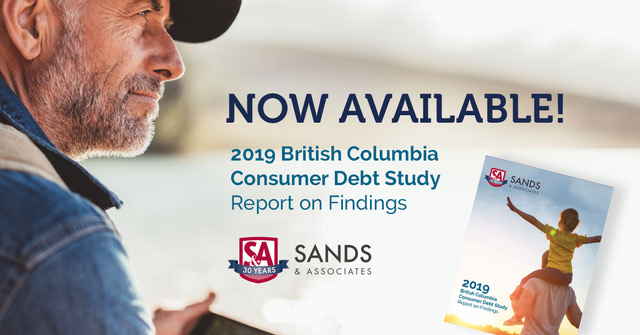The latest annual BC Consumer Debt Study was released today by Sands & Associates, and findings may be surprising – especially for consumers who think they’re safe from the potential pitfalls of debt.
Senior Vice-President of Sands & Associates and Licensed Insolvency Trustee Blair Mantin joined Global News to share some of the key insights from the new study.
Watch the clip here, and read more below:
Why Study Consumer Debt Trends?
Over the last 30 years Sands & Associates has helped thousands of people in BC take charge of their debts and get a financial fresh start – we believe that our approach based on empathy and support are vital to the future success of our clients. With this in mind, it is our aim to be able to have real insight into how people manage their debt before coming to Licensed Insolvency Trustees for help, and how debt impacts their daily lives – this enhanced understanding allows us to deliver the best service and support possible.
As Senior Vice-President and Licensed Insolvency Trustee Blair Mantin outlined:
“Not only is it our intention to highlight the struggles that dealing with overwhelming debt can bring into everyday life, we also hope that these findings may help consumers in similar situations relate and seek assistance early on, as well as offer a fresh perspective to others who may not understand just how quickly money troubles can start, or the conflicted and intense feelings that overwhelming debts can place on someone – your family, friends, co-workers…or even yourself.”
Each annual BC Consumer Debt Study takes an in-depth look at the debt levels and causes of financial difficulty people were facing, with an additional area of focus each year as well. Past special focuses have included topics such as:
- Payday loan usage in BC;
- Financial literacy;
- The correlation between supporting dependents and debt-levels;
- Financial outlooks before and after filing bankruptcy;
- Student finances.
Some of the additional findings from this most recent study include insights into:
- Income sources, housing and credit ratings at the time respondents were seeking debt help;
- What caused respondents to delay seeking debt help;
- Advice from consumers across BC who made a Consumer Proposal or filed personal bankruptcy.
Read the full 2019 BC Consumer Debt Study here.
Summary of Key Findings from Sands & Associates’ 2019 BC Consumer Debt Study
BC Consumers are Seeking Debt Help to Deal with Unforeseen Events
- The most common main cause of debt cited by study participants was “overextension of credit, financial mismanagement” – which nearly 30% of respondents identified.
- The next-most cited causes of debt all relate to issues that could largely be considered outside of an individuals’ control, relating primarily to employment, health and relationships.
- The sum total of respondents who cited Job-related issues (15%); Illness, injury or health problems (14.2%); and Marital or relationship breakdown (10.7%) comprises 40% of the total of the survey respondents.
A noteworthy takeaway from this year’s study is the financial “best practice” of maintaining an emergency fund to deal with unforeseen expenses or income interruptions. Although often difficult to achieve, generally it would be advisable to have savings representing 3-6 months of fixed costs in a separate emergency fund that is never touched – this can provide significant breathing room in times of financial crisis.
BC’s Indebted Consumers are Getting Older
- Nearly 40% of individuals polled who had filed a Consumer Proposal or personal bankruptcy were aged 55 or older, indicating that debt is an increasing concern for individuals approaching the end of their working life, or already in retirement.
- The proportion of respondents aged 55 or older has increased significantly since our 2012 study, when 26.3% of respondents fell into this age category. In our 2016 study, the percentage of respondents aged 55 or older grew to 35.8% before reaching 39.3% in the 2019 Consumer Debt Study.
In our experience as Licensed Insolvency Trustees, many clients quite often find that their pension income has not kept pace with inflation in recent years. As well, many individuals aged 55 and over that we help had hoped to be debt-free by retirement, but ultimately ended up carrying interest-bearing debt into retirement that eventually strained their finances.
Over 70% Who Filed for Bankruptcy or Made a Consumer Proposal were Employed or Self-employed
- The sum total of individuals working full-time, working part-time, or self-employed comprised more than 70% of the total survey respondents.
- 7% of respondents indicating their primary income source was retirement pension income.
Although the majority of respondents indicated their primary income source was derived from full-time work (54.3%) or self-employment (8.2%) at the time they sought assistance, it is evident that these earnings were ultimately insufficient to effectively service debt-loads and that hard work alone does not necessarily equate a solution to deal with a debt problem. The survey responses also highlight a sad reality that many pensioners may be ill-equipped financially to deal with the costs of retirement.
Homeowners Have Been Largely “Safe” – Thus Far
- Just 4.4% of respondents described their housing situation as “homeowner” at the time they sought professional debt help.
- The overwhelming respondent majority indicated they were renting (79.4%) or sharing a rental unit with roommates (5.8%) at the time they sought debt solutions.
The simple explanation for this low proportion of homeowners is the rapid and sustained appreciation of real estate prices in BC for several years. Many homeowners who have found themselves in trouble with debt have been able to access Home Equity Line of Credit (“HELOC”) financing or have refinanced their mortgage for a higher amount to pay off other debts. Once BC real estate prices stop increasing, we expect this number to change.
Having a High Credit Rating Does Not Offer Protection from Debt Problems
- Close to one third (29.6%) of respondents indicated that their credit score could be described as ranging between “good” and “excellent” at the time they started their debt relief process (either by making a Consumer Proposal or filing personal bankruptcy).
Debt help industry professionals often caution that credit ratings and credit scores are an imperfect measure for consumers to rely upon when evaluating their financial health. This concern is evident in the results of the 2019 BC Consumer Debt Study, which illustrates that having a good-to-excellent credit rating does not inoculate consumers against having to restructure their debts.
Read the full 2019 BC Consumer Debt Study here.
Contact Sands & Associates today for more information about the debt help services offered by Licensed Insolvency Trustees, or to book your confidential free debt consultation and get plan to deal with your debts – we have local offices throughout the province to serve you.






